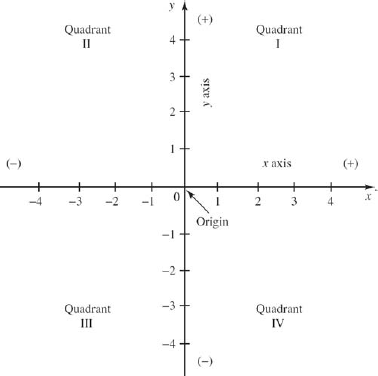5.1. Rectangular Coordinates
In Chapter 1 we plotted numbers on the number line. Suppose, now, that we take a second number line and place it at right angles to the first one, so that each intersects the other at the zero mark, as in Fig. 5-1. We call this a rectangular coordinate system.
The horizontal number line is called the x axis, and the vertical line is called the y axis. They intersect at the origin. These two axes divide the plane into four quadrants, numbered counterclockwise, as shown.
Figure 5.1. The rectangular coordinate system. Rectangular coordinates are also called Cartesian coordinates, after the French mathematician René Descartes (1596–1650). Another type of coordinate system that we will use later is called the polar coordinate system.

Figure 5-2 shows a point P in the first quadrant. Its horizontal distance from the origin, called the x coordinate or abscissa of the point, is 3 units. Its vertical distance from the origin, called the y coordinate or ordinate of the point, is 2 units. The numbers in the ordered pair (3, 2) are called the rectangular coordinates (or simply coordinates) of the point. They are always written in the same order, with the x coordinate first. The letter identifying the point is sometimes written before the coordinates, as in.
Figure 5.2. Is it clear from this figure why we call these rectangular coordinates?
5.1.1. Graphing ...
Get Technical Mathematics, Sixth Edition now with the O’Reilly learning platform.
O’Reilly members experience books, live events, courses curated by job role, and more from O’Reilly and nearly 200 top publishers.

